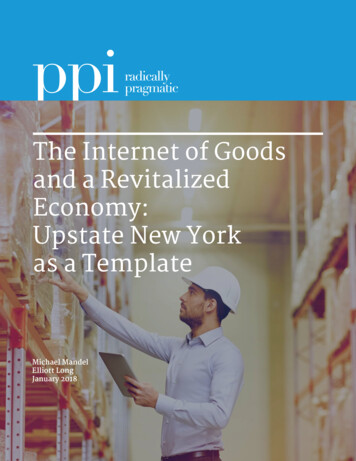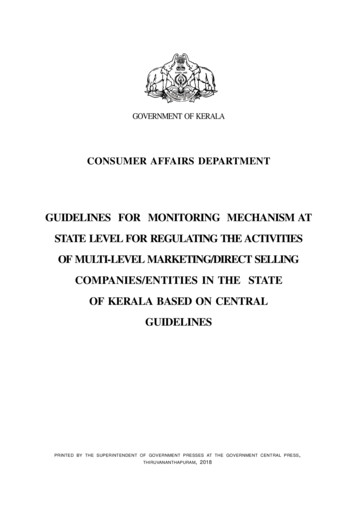
Transcription
THE INTERNET OF GOODS AND A REVITALIZED ECONOMY: UPSTATE NEW YORK AS A TEMPLATEThe Internet of Goodsand a RevitalizedEconomy:Upstate New Yorkas a TemplateMichael MandelElliott LongJanuary 2018P1
THE INTERNET OF GOODS AND A REVITALIZED ECONOMY: UPSTATE NEW YORK AS A TEMPLATEThe Internet of Goodsand a Revitalized Economy:Upstate New Yorkas a TemplateJANUARY 2018Michael MandelElliott LongINTRODUCTIONBased on new business models, as well as newtechnology, digitally-driven manufacturing canprovide an essential jumping-off point forgrowth. As we recently wrote in a policy report:2A revival in localmanufacturing could provide anew source of jobs for areas ofthe country that have suffereddisproportionate job losses inrecent years. The key to thisrevitalization is integratingdigital technology intoevery stage of the research,development, distribution anddelivery of the goods produced.We call this integration theInternet of Goods and believeit is poised to revitalizephysical industries such asmanufacturing, agricultureand transportation.1We believe that, through additivemanufacturing and other new technologies,combined with the new faster localdistribution networks, there is the possibilityof creating new business models formanufacturing. In particular, there is thepotential for the revival of small-scalemanufacturing operations, relatively closeto customers, making small-batch andcustom goods.Digitally-driven manufacturers won’t locate indense urban areas where land prices are highand logistics for transporting the manufacturedgoods are complex, time consuming andexpensive. Instead, they will gravitate to areas ofthe country that have sufficient, available land;have a strong base of workers comfortable withtechnology; and have access to a high-capacitybroadband network infrastructure.P2
THE INTERNET OF GOODS AND A REVITALIZED ECONOMY: UPSTATE NEW YORK AS A TEMPLATEThe question we consider here: How can publicpolicy encourage this turnaround and catalyzethe growth of Internet of Goods industries?The conditions in upstate New York –particularly the region from Buffalo to Rochesterto Syracuse – provide a real-world test bed todetermine best practices for attracting andretaining Internet of Goods industries. With itsworld-class universities, access to interstatehighways and shipping routes, educatedworkforce, and ample building space vacatedby former manufacturing plants and otherindustries, this region possesses many essentialqualities to forge a robust Internet of Goodseconomy. Buffalo, Rochester, and Syracuse arealready seeing a rise in economic vibrancy anda growth in high-end tech jobs as a result ofstate policy.Like many areas around the country, upstateNew York is at a crucial juncture: Can thestate make the policy decisions necessary toaccelerate growth and help the most people? Toadd to all the good work that has been done sofar, what’s needed are policies that encouragebroadband companies to bring high-speedbroadband networks to these areas of thecountry that are ideally suited for digitally-drivenmanufacturing companies, while not takingactions that delay or depress the build-out ofthese networks by making it cost prohibitiveto build them.Because new Internet of Goods industriesincorporate real-time data and advancedanalytics into their business practices, highspeed high-capacity mobile broadband isessential. Unfortunately, some upstate citiesare imposing new and prohibitive costs on theinstallation of the equipment needed to bringhigh-speed mobile broadband to more upstatecities and towns. This impulse to collect highfees in the near term will likely come at theexpense of revitalizing upstate New York withInternet of Goods industries and the new jobsthat will produce.P3
THE INTERNET OF GOODS AND A REVITALIZED ECONOMY: UPSTATE NEW YORK AS A TEMPLATEINGREDIENTS FOR SUCCESS:THE CASE OF UPSTATE NEW YORKHow can public policy spur momentum andbring back industries and jobs to upstate NewYork? Fortunately, many of the necessaryingredients are already in place throughoutthe region: a rich academic environment,ample space for the siting of new industrialfacilities, good transportation, and a tech-savvyworkforce.innovative businesses. For example, the BuffaloManufacturing Works, which began as part ofNew York State Governor Andrew M. Cuomo’sBuffalo Billion Investment Development Plan, iscurrently helping local manufacturers integratethe latest technologies into their businesses.3The goal is to be a center of excellence for newmanufacturing technologies such as additivemanufacturing. Panasonic has been hiringseveral hundred workers to help build solarpanels at Tesla’s Solar City plant in Buffalo.4First, upstate New York starts out with awealth of topnotch universities. These include,among others, Cornell University, the Universityof Rochester, the Rochester Institute ofTechnology, Rensselaer Polytechnic Institute,Syracuse University, the University at Buffalo,Binghamton University, and the University atAlbany. These higher education institutions givethe region not only fertile research facilities, buta built-in pipeline for an educated workforce.Cuomo’s “Upstate Revitalization initiative”has helped support Syracuse’s revival aswell.5 Cuomo prioritized drone research anddevelopment as a growth industry for the RomeSyracuse corridor, and state investments havepositioned the area as a hub of drone research,development and manufacturing.6 State policiesare spurring new drone-related companies suchas Rome-based SkyTube Live and GryphonSensors in Syracuse. In addition, the NortheastUAS Airspace Integration Research Alliance(NuAir Alliance) announced in September 2017that the first phase of the 50-mile drone researchcorridor is operational, and based at Griffiss AirForce Base in Rome.7Ironically, because the region has experienced aheavy loss of mainstay manufacturers, it has asignificant inventory of attractive and affordablelocations in which new manufacturing industriescan locate. Further, a well-connected highwaysystem provides transportation routes thatresolve logistics and distribution issues for newindustries. Thanks to forward-looking statepublic policy, heavy investment in infrastructureand downtown placemaking has begun toattract young people and startups, making manyof these cities more desirable places to live.Indeed, the 150-mile stretch from Buffalo toRochester to Syracuse is poised to regain someof its economic luster. In part because of theNew York State initiatives listed above, Erie,Monroe, and Onondaga Counties have beenattracting tech jobs in software, ecommerce,and Internet-related businesses.8 The tablebelow shows these gains, even as traditionalmanufacturing jobs have declined dramatically.Indeed, thoughtful state policies – whether taxincentives, operational support, or opportunitiesto collaborate with public and private institutions– are already helping upstate New York attractP4
THE INTERNET OF GOODS AND A REVITALIZED ECONOMY: UPSTATE NEW YORK AS A TEMPLATEFIGURE 1: Growth in Software, Ecommerce, and Internet-related Tech Jobsin Selected Upstate New York RegionsCHANGE IN SOFTWARE, ECOMMERCE, AND INTERNETRELATED JOBS (2007-2016)*CHANGE IN MANUFACTURING JOBS (2007-2016)ERIE COUNTY(BUFFALO)2096-7062MONROE COUNTY(ROCHESTER)2591-15626744-7862ONONDAGA COUNTY(SYRACUSE)* includes NAICS 4541, 5112, 518, 519, 5415, 5416 and the change in 493 since 2007. Data: BLS, PPIThe connection between deliberate public policyand tech growth in upstate New York goes backto the Pataki Administration, which gatheredleaders in business and industry to develop astrategy to encourage next-generation industriesin New York. One result of that effort wassupport for the state’s semiconductor industry.9That industry, in turn, is a key platform for newnanomanufacturing companies acrossthe region.Taken together, these new technologies havethe potential to greatly boost the productivityof U.S. factory workers, which, surprisingly,has languished in recent years. In turn, asproductivity rises, the cost of productionand distribution will fall, enabling localmanufacturers to greatly expand their regionalsales and creating opportunities for hiring techenabled workers to complement automatedproduction. And a new crop of manufacturingstartups will arise to create new products andservices we can’t even imagine now.THE INTERNET OF GOODSWe believe that the next wave of digitally-drivenmanufacturing – what we call the Internet ofGoods – has the potential to revitalize areassuch as upstate New York. The Internet ofGoods is the convergence of several trends thatmay lead to a revival of local manufacturing.These trends include robots and additivemanufacturing, which enable companiesto effortlessly shift between small-batch orcustom production runs. The rise of ecommercefulfillment centers gives manufacturers theability – for the first time ever – to cheaply shipindividual items directly to their customers.And cloud platforms will cheaply provide theessential advanced analytics and machinelearning that tie the new technologies together.With abundant land, access to goodtransportation, a sufficiently large skilledworkforce, leading-edge educational institutions,and support from the state government,upstate New York is well positioned to takeadvantage of the Internet of Goods. Imagine,if you would, a startup in the Buffalo area thatuses production-quality additive manufacturingtechniques to quickly make custom furniture ondemand, and ship it out the next day to a localfulfillment center for rapid delivery across a 200mile radius. That would provide a sustainablecompetitive advantage against foreign rivalsthat are limited to floating large containers ofidentical goods over 10,000 miles.P5
THE INTERNET OF GOODS AND A REVITALIZED ECONOMY: UPSTATE NEW YORK AS A TEMPLATEAN ANALYSIS OF IMPEDIMENTS TOCONTINUED REVITALIZATION IN UPSTATENEW YORK: SMALL CELL POLICYThe Internet of Goods requires access to highcapacity, high-speed broadband infrastructure– and, unfortunately, that’s where Upstate NewYork is falling short. Today’s wireless technologyis typically powered by large towers, spreadrelatively far apart. But the next generation ofwireless broadband networks, usually called5G networks, are essential infrastructure forthe Internet of Goods. They provide enoughbandwidth to power driverless trucks, guidedrones without interruption, and support digitalmanufacturing.Now think about a thickening network of suchlocal manufacturers, each of them growingand hiring.Of course, it’s not just manufacturing, but alsohealthcare, education, and the whole range ofphysical industries that will be transformed byaccess to high-speed broadband. Ultimately,the acceleration of productivity growth andjob creation in the physical industries that thenext generation of wireless broadband willhelp facilitate creates a lot more tax revenuethan collection of near-term fees to site theequipment needed to build such networks.On a national level, Mandel and Swansonrecently estimated that the application of thenext generation of wireless and other newtechnologies to physical industries could add0.7 percentage points to annual national GDPgrowth, which makes an enormous differenceover time to the size of the economy andtax revenues.5G networks will be built on millions of smallcells throughout the country. 5G networks willuse laptop-sized antennae cells that can beplaced in buildings or outdoors on utility poles,light poles, traffic lights, or exterior walls ofbuildings. These cells can transmit a lot of data,but over a short range, so that a robustbroadband network needs to have many cells.By 2031, the higher growth rate pushes up U.S.GDP by 11 percent compared to its previouspath, or 2.7 trillion (in 2016 dollars). That’senough to significantly lift incomes and livingstandards, as wage and salary payments wouldrise by a cumulative 8.6 trillion over the next15 years, in 2016 dollars. In addition, the largereconomy would yield around 3.9 trillion incumulative federal revenues and 1.9 trillion inadditional state and local revenues over the 15year period, all without increasing the tax shareof GDP.In terms of attractiveness for small cellbuildout, upstate New York’s cities start outwith a handicap relative to comparable cities.Figure 2 calculates GDP density for selectedurban industrial MSAs in the Northeast andMidwest. We note that Rochester and SyracuseMSAs have a lower GDP density and a muchslower growth rate than either Pittsburgh orWorcester. That suggests the local governmentsin Rochester and Syracuse may want to avoidhindering the deployment of small cells for5G networks.P6
THE INTERNET OF GOODS AND A REVITALIZED ECONOMY: UPSTATE NEW YORK AS A TEMPLATEFIGURE 2: GDP Density and Growth for Selected MSAsMSAGDP DENSITY(GDP PER SQUARE MILE, MILLIONS)REAL GDP 26.217%ROCHESTER18.9-1%SYRACUSE13.70%BOSTONData: Census, BEA, PPIBuffalo is somewhat better positioned, butissues still remain. Buffalo is way behindCleveland and Detroit in terms of GDP density,but ahead in terms of growth. Columbus andAustin have the same GDP density, but muchfaster growth rates. Buffalo should not enactpolicies that further handicap itself.Similarly, Iowa passed legislation providinga series of uniform rules for the permitapplication process for and deployment ofsmall wireless facilities.11 The legislation alsoprohibits local governments from charging anannual recurring rate for small cell attachmentto municipal poles in excess of federal laws.Florida also passed legislation earlier this year,pre-empting local government control of rightsof-way for installation of wireless antennasand equipment.12 The legislation also prohibitspermit and pole attachment fees.At least nine states have passed legislationto encourage the deployment of small cells,including Minnesota, Iowa, Kansas, Virginia,Florida, Indiana, Arizona, and Colorado. Thelaws these states adopted establish a uniformprocess for installing small cells and limitthe fees localities can charge to reasonableamounts. For example, earlier this year Virginiapassed S. 1282, establishing guidelines andtimelines for permitting decisions, limitingapplication fees to 100 per cell and prohibitingright-of-way fees.10By contrast, some upstate New York localitiesare considering ways to impose significantfees on small cell installations. Slic NetworkSolutions, a company that has been expandinghigh-speed access throughout rural northernNew York using fiber optics, recently said thatgaining access to poles could account for up toP7
THE INTERNET OF GOODS AND A REVITALIZED ECONOMY: UPSTATE NEW YORK AS A TEMPLATECONCLUSIONAs a result of thoughtful New York state policies,new industries are putting communities inupstate New York on the path to economicrevitalization; however, a robust, evolvingnetwork that will support 5G technologies is anessential element for the continued success ofnew companies and additional future-orientedindustries in the region. Unfortunately, somelocal governments have unwittingly underminedthis goal by setting fees to install small cellequipment that discourage investment bybroadband companies. As a result, broadbandcompanies will find alternative sites for buildingout their networks, jeopardizing not only thefuture of new industries that have locatedupstate, but also closing the door to futureindustries and revenues they would generate.Upstate New York should complement itsuniversities, workforce, transportation andaffordable land advantages by encouragingthe essential high-speed, high-capacitybroadband network to power futureindustries and create jobs.40 percent of their expansion costs, sometimesat a price between 10,000 and 14,000 permile.13 The city of Buffalo’s 2017-2018 adoptedbudget includes an annual fee of 2,000 perpole, as well as application and processingfees in the upcoming fiscal year, for telecomoperators to install and maintain small cells.14Syracuse is considering legislation that wouldcharge carriers an annual fee of 1,000 to 2,000 per installation depending on thetype of pole.15And, unfortunately, the New York State Senateis considering a bill that would direct the publicservice commission to prohibit the attachmentof wireless equipment to utility poles unlessexisting easements are amended or neweasements are written.16 Legislation suchas this – that codifies barriers to small cellinstallation – will slow the small cell installment,hurting the growth of Internet of Goodsbusinesses in New York.About the AuthorsDr. Michael Mandel is the chief economic strategist at theProgressive Policy Institute and a senior fellow at Wharton’s MackInstitute for Innovation Management.Elliott Long is Economic Policy Analyst for the Progressive PolicyInstitute. Elliott holds a BA in Political Science from Florida GulfCoast University and an MPA from George Washington University.P8
THE INTERNET OF GOODS AND A REVITALIZED ECONOMY: UPSTATE NEW YORK AS A TEMPLATEReferences1Michael Mandel. “Get Ready for the Internet of Goods,” Wall Street Journal Commentary, October 2017.2Michael Mandel. “The Next Ten Million Jobs: Energizing the Physical Industries in the Heartland States.”Progressive Policy Institute, October 4527415Rick Moriarty, “Central New York a winner in Cuomo's 1.5 billion Upstate revival initiative,” Syracuse.com, December 10, 2015. 15/12/central new york a winner in cuomos 15 billion upstate revival initiative.html6Patrick Miller, “NUAIR announces first phase of New York UTM corridor,” UAS Magazine, November 8, 2017. es-first-phase-of-new-york-utm-corridor7Lauren Sigfusson, “New York’s Drone Superhighway Officially Launches,” Discover Magazine, September 29, 17/09/29/drone-superhighway-new-york8We focus on these counties because they are the leaders in software employment in New York state, outside of Albany and the NewYork City region.9The National Academies, “The New York Nanotechnology Initiative,” Best Practices in State and Regional Innovation Initiatives:Competing in the 21st Century. 2013. https://www.ncbi.nlm.nih.gov/books/NBK158826/10 “SB 1282,” Virginia General Assembly. https://lis.virginia.gov/cgi-bin/legp604.exe?171 sum SB128211“SF 431,” Iowa Legislature. https://www.legis.iowa.gov/legislation/BillBook?ga 87&ba SF43112“HB 687,” Florida Senate. ake Newman and Brian Molongoski, “In Northern New York, Broadband Expansion Faces Challenges,” Governing.com, October 30,2017, http://www.governing.com/templates/gov print article?id 45411568314“Fiscal Year 2017-2018 Adopted Budget Highlights,” City of Buffalo. https://www.ci.buffalo.ny.us/files/1 2 1/Mayor/20172018AdoptedBudget/Mayors f/2017/06/syracuse gears up for next wave of high-speed wireless technology.html16“Senate Bill S6687,” New York State Senate. 687P9
THE INTERNET OF GOODS AND A REVITALIZED ECONOMY: UPSTATE NEW YORK AS A TEMPLATEThe Progressive Policy Institute is a catalyst for policy innovationand political reform based in Washington, D.C. Its mission is to createradically pragmatic ideas for moving America beyond ideological andpartisan deadlock.Founded in 1989, PPI started as the intellectual home of the NewDemocrats and earned a reputation as President Bill Clinton’s “ideamill.” Many of its mold-breaking ideas have been translated into publicpolicy and law and have influenced international efforts to modernizeprogressive politics.Today, PPI is developing fresh proposals for stimulating U.S. economicinnovation and growth; equipping all Americans with the skills and assetsthat social mobility in the knowledge economy requires; modernizing anoverly bureaucratic and centralized public sector; and defending liberaldemocracy in a dangerous world.P10 2017Progressive Policy InstituteAll rights reserved.Progressive Policy Institute1200 New Hampshire Ave NW,Suite 575Washington, DC 20036Tel 202.525.3926Fax g
and tech growth in upstate New York goes back to the Pataki Administration, which gathered leaders in business and industry to develop a strategy to encourage next-generation industries in New York. One result of that effort was support for the state's semiconductor industry.9 That industry, in turn, is a key platform for new











